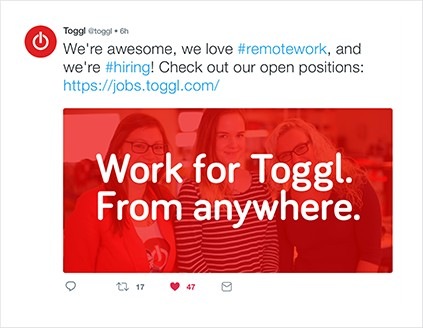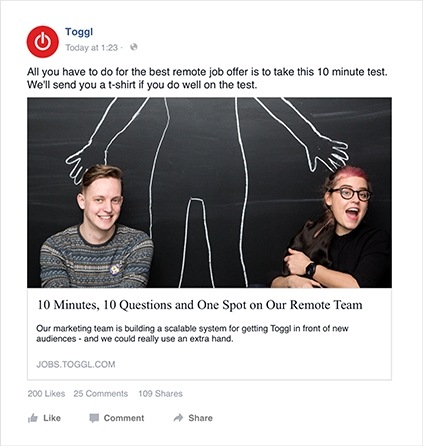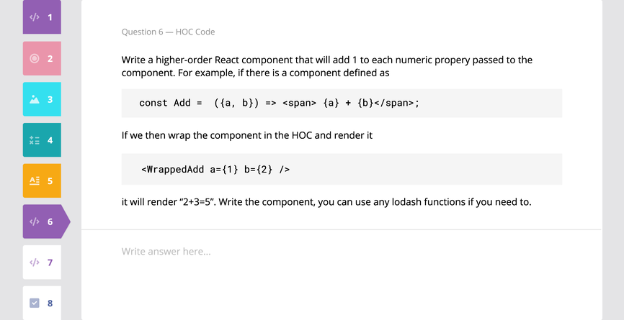03Hiring remote talent: How to set up a successful remote hiring pipeline
Here’s how we’re able to do it time and time again at Toggl Track with our hiring app Toggl Hire.
When hiring remotely, you get access to an incredibly vast talent pool. This is both good and bad for you as the employer. On the one hand, there are more people to choose from, all over the globe. On the other, you will be swamped with unqualified candidates.
With remote work, lots of candidates think it’s fun and ‘pretend-work’, and you need to shatter the illusion for applicants as soon as possible. To make sure you get strong candidates to apply for your jobs:
Highlight the responsibilities, what is defined as success in that role and what qualities the candidate needs to possess in order to thrive in the position. We suggest using performance-based job descriptions. Simply put, the job description should focus on precisely what the applicant should be able to do, first and foremost. Instead of focusing on desirable experience, education and character traits, focus on what matters - their ability to get work done.
Explain what it means to work remotely and what kind of an arrangement it entails for potential new employees. Stress the necessary aspects of working remotely: self-discipline, strong communication skills, excellent organization and the ability to function within a team. It is crucial that candidates are aware of all the aspects of working remotely before they proceed with their application.
If you’re keen on posting your ad someplace, go for niche job boards and those focusing on remote work only. Sites like WeWorkRemotely, Remote.co, FlexJobs, and others focus exclusively on remote positions. By placing your ad in places like these, you are getting in front of an audience that knows the ins and outs of remote work - the people that are actively looking for remote jobs only. We stay away from regular job boards and instead focus on social media, coupled with precision targeting to reach the best people for the job.


Spending more time in the early stages (on creating a quality application) will save you even more time along the line. Instead of dealing with 2000 applicants, you’ll have 500-1500 per position. These are the numbers we’ve been getting at Toggl Track, using social media only.
The great news is - you’ll get a lot of applicants. Some not-so-great news – most of them won’t be really good.
Around 80% of the 500-1500 people who apply won’t be a good fit for the position. If you’re hiring the traditional way, this means that you’ll have to put in some serious elbow grease to get to the 20% that could work out, and then fine-tune that to the last 5-10 candidates you can call in for an interview. The problem with this approach is that you spend the most time on those candidates that least deserve it.
For effective candidate pre-screening, we use our own skills-based hiring app, Toggl Hire.We come up with a skills-based test with around 10 questions per position. The tests are usually a mix of skills specific mutliple choice questions, short coding tasks, logic questions, and some creative open-ended questions - whichever questions are relevant to the role and help us quickly weed out unqualified candidates.

The candidates apply for the job by taking the short test. Once they’ve answered all the questions, we get immediate results on who could potentially make a great hire - without even taking a look at the resume.
The real time saver here is not having to look at resumes and cover letters. They’ve proven to be ineffective for traditional hiring, and even more so for remote jobs.
As a bonus, Toggl Hire gives candidates rapid feedback on their application. If they don’t pass the test threshold, they immediately get a rejection email. You get to be effective and polite at the same time – a win-win situation.

Speaking of which, Toggl Hire ensures that you only see the results of the candidate first - nothing else. In this way, all bias is completely removed. You won’t base your hiring decision on gender, age, ethnicity, religion, country of origin or anything similar - just the ability to get the job done.
By this time, you should have already narrowed down your candidate list by quite a lot. We’re using 10% as an example only, as it would be 50-150 candidates in our example case. In most cases, this is not more than 10 people doing a home task. Its purpose is to show you who can do the work that the position requires and further cut down the list of candidates to the best of the best.
For example, developers are tasked with writing a certain amount of code. A marketer should make a landing page and set up ads for a campaign. A product specialist should come up with an alternative onboarding flow for a product, etc
Besides testing candidate skills, this part of the hiring process also tests their dedication. If someone is willing to put aside a few hours for a home task, they are definitely interested in working with your team.

This part is no different from hiring in more traditional ways. However, since you’ve done most of the screening using a skills-based test and a home task, you already know quite a lot about the candidate. Instead of checking whether they can actually do the job, you can talk about other things. This can be the results of their home task, their day-to-day work, previous experience, their vs. your expectations for the position etc. Since the candidate already knows the type of work they would be doing and that they can do it well, there is less stress involved for the candidate.
The main focus of the first interview is to assess the candidates’ communication skills. One of the keys to success in remote work environments is excellent communication. If the candidate knows how to do the job well and they’re a great communicator, they’re ready to move on to the next round.
We’re strong believers in test drives. If you want to ensure something will work in the long run, it’s a pretty good idea to test the waters first before dipping in. For each of our new hires, we set up a paid trial period of 2-5 days, depending on the role.
Once we find our best candidates (1-3 people), we invite them for a paid test week at Toggl Track. For 2-5 days, the best candidates get to work alongside the team, performing the usual tasks for the position.
It may sound unconventional, but it has benefits both for us and the candidate. We can see how well the candidate performs, if they fit in with the rest of the team and if they can function remotely. On the other hand, the candidate gets to see what the position is all about and if your company is the right place for them.
Note that this part is completely optional. If you’ve already found your ideal candidate using just the home task, there is no need for a paid test week to take place.
At this point, you’re left with a single candidate that ticks all of the boxes. They get to sit down with the team lead, the company CEO and other relevant team members
In comparison to traditional hiring methods, the final interview is much different. The candidate has already gone through several stages: the initial screening with Toggl Hire, the home task, and the paid test week. As the employer, you have plenty of information to make a sound hiring decision. What’s more, your (potential) new employee already has a great feel for what’s it like to work with your team. All that’s left is to make an offer and watch your company grow by one more skilled team member.

Your remote hiring process may differ, but this is the one that works best for us. It is scalable and sustainable - you can repeat it as many times as you want, only changing the methods for testing. However, the biggest strength in this practice lies in the time and resources saved by quickly writing off the bulk of unqualified candidates. We hope that you too will be able to use these tactics to quickly and efficiently hire quality remote workers.
Continue reading
- 01 Why go remote - the pros and cons of becoming part of a distributed team.
- 02 Building distributed teams: everything you need to know
- 03 Hiring remote talent: How to set up a successful remote hiring pipeline
- 04 Growing your remote team: how to onboard new members and set expectations
- 05 How to make remote teams work: Culture is crucial
- 06 How to lead a great remote team: the importance of letting go